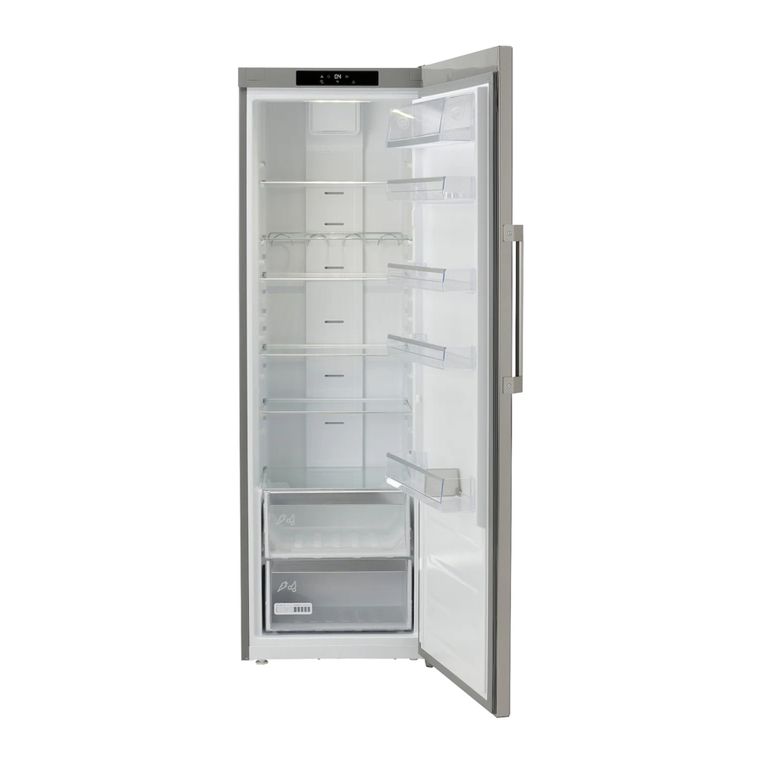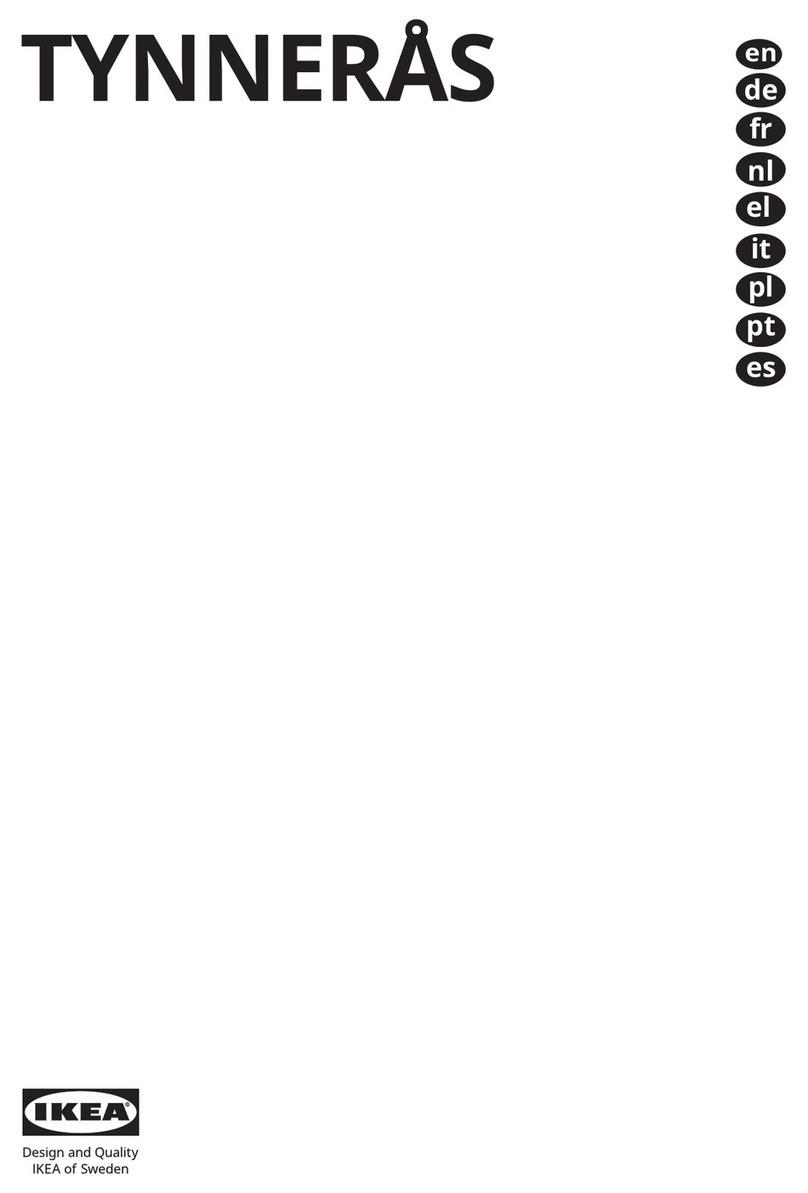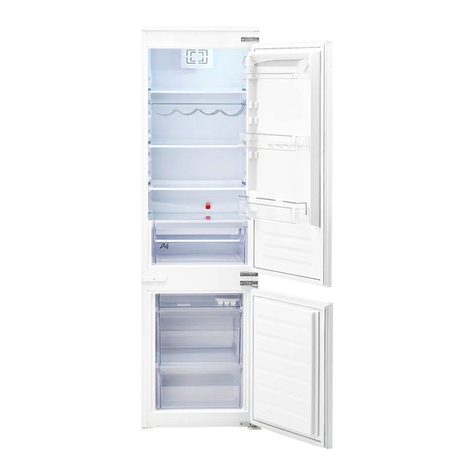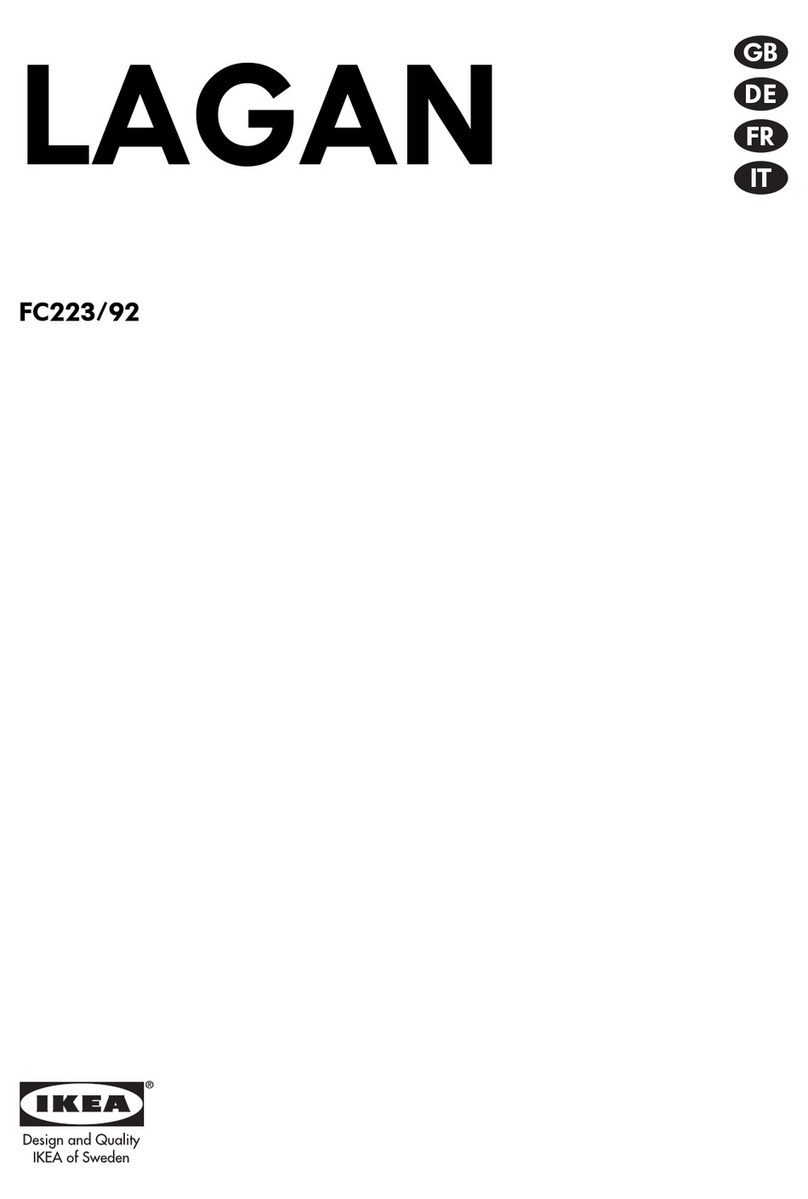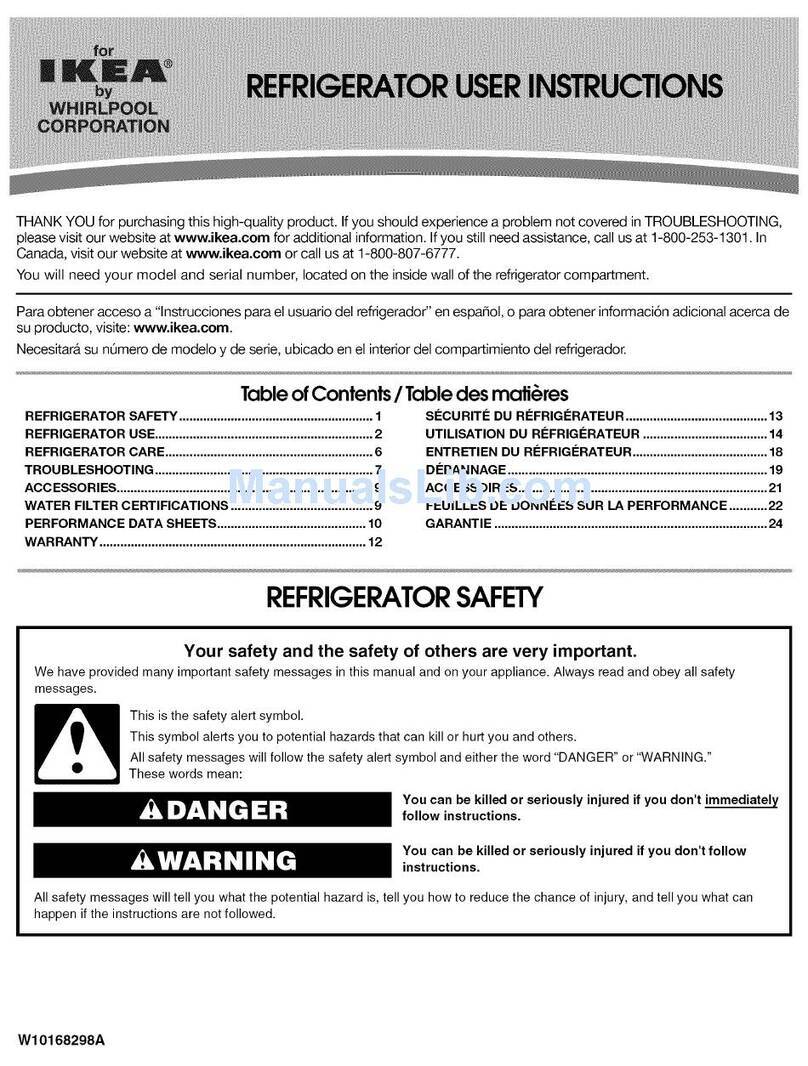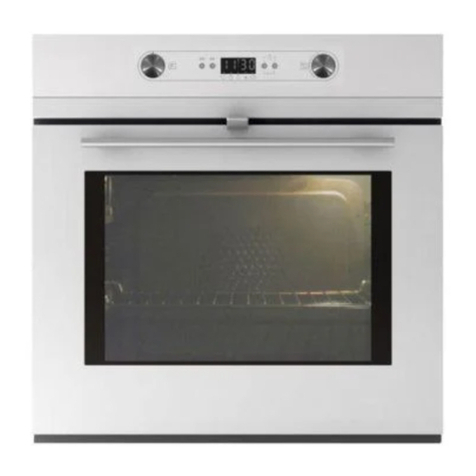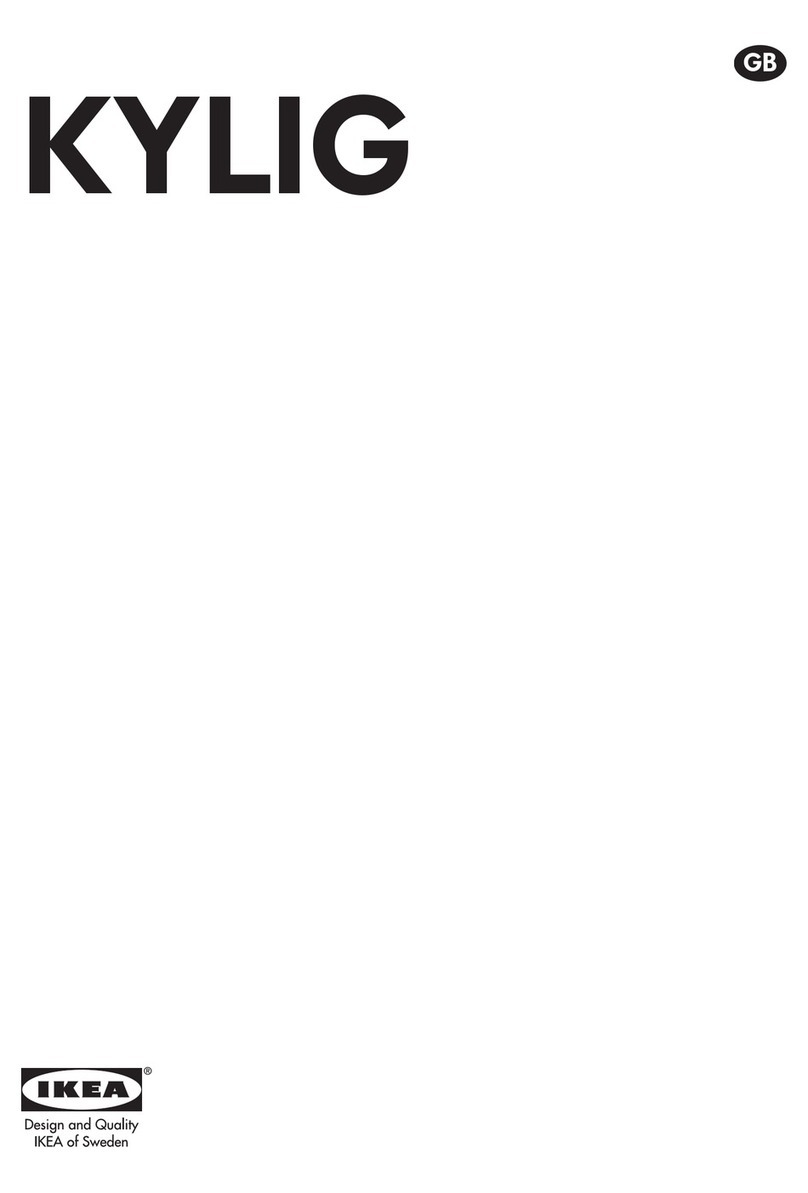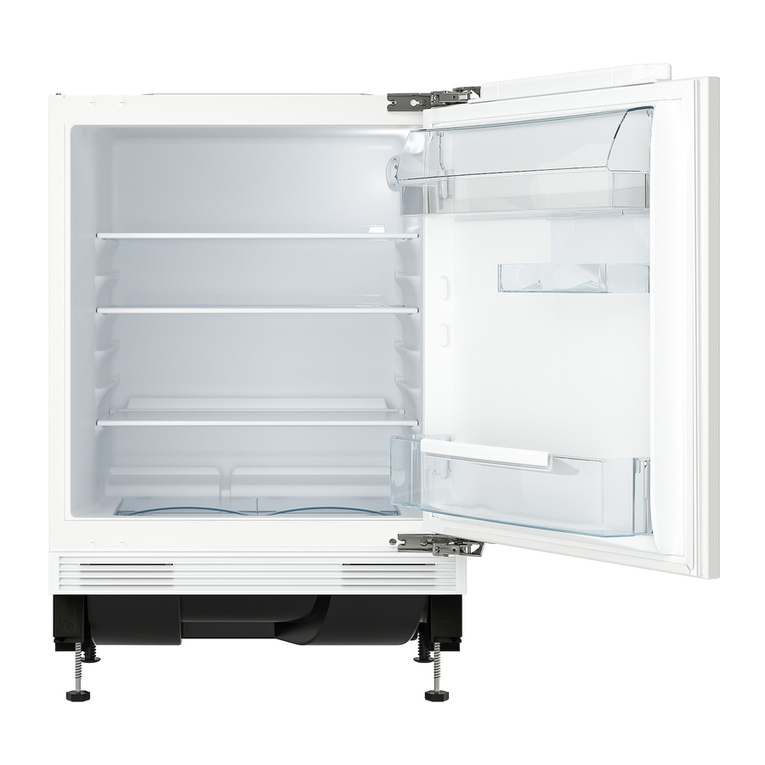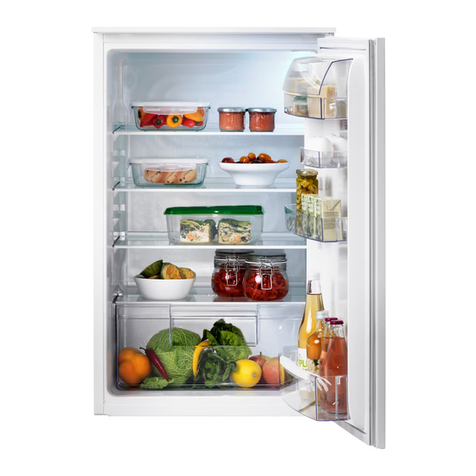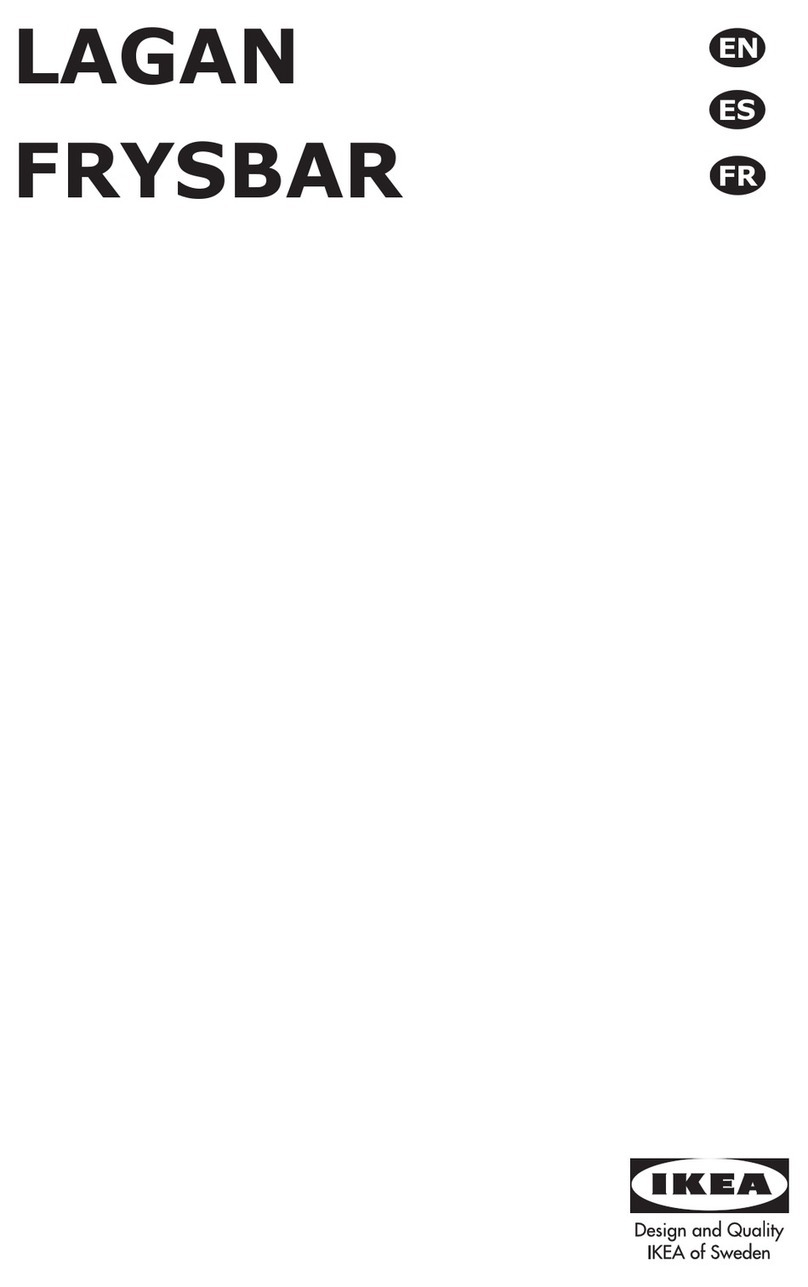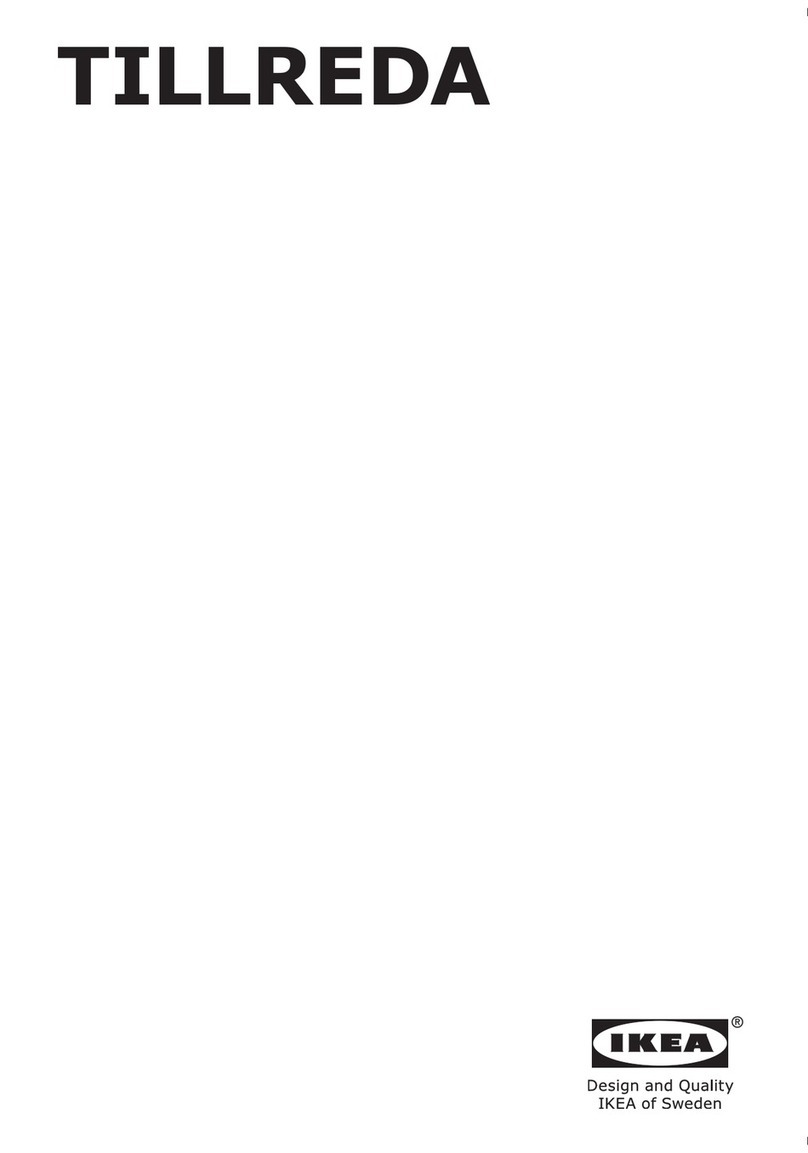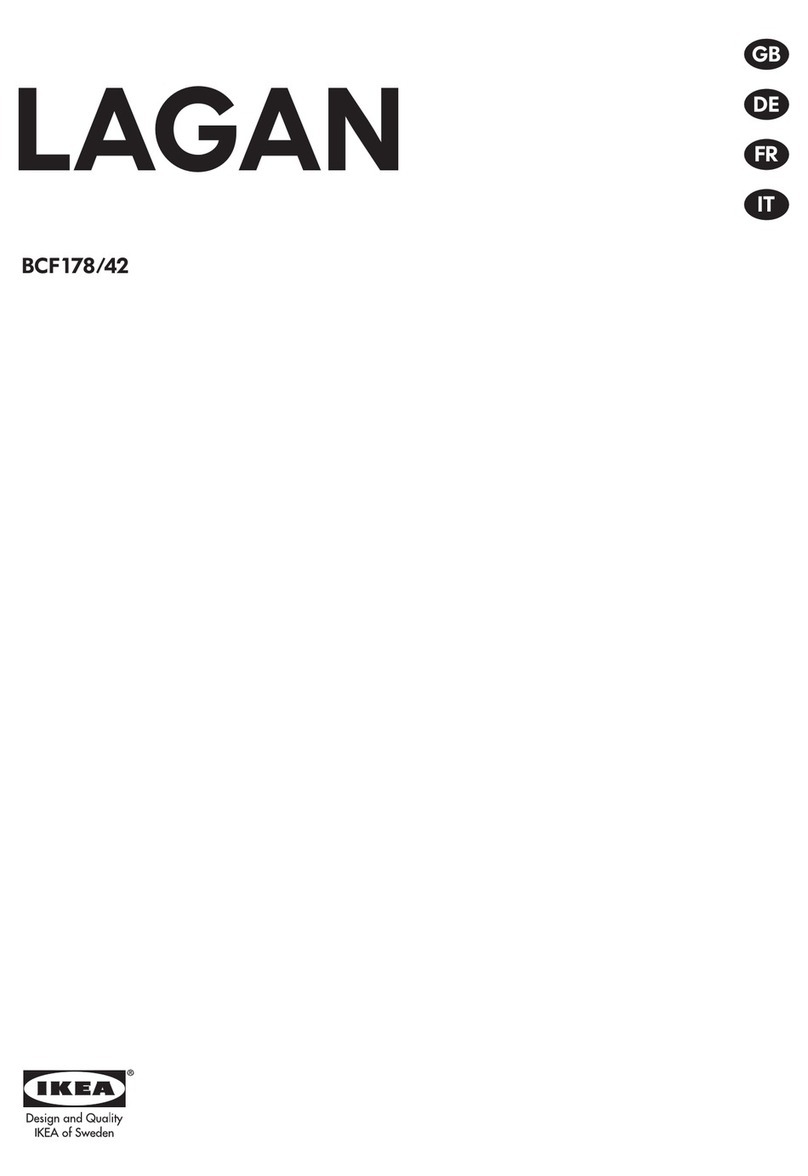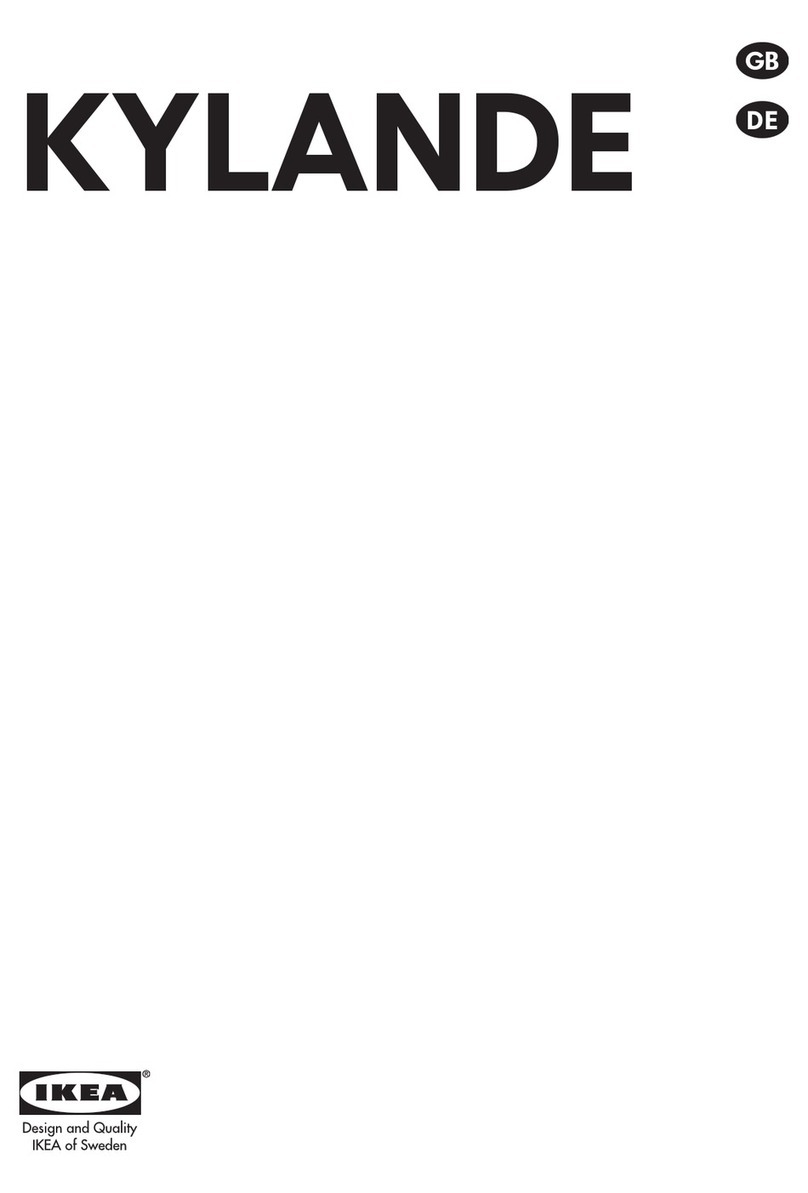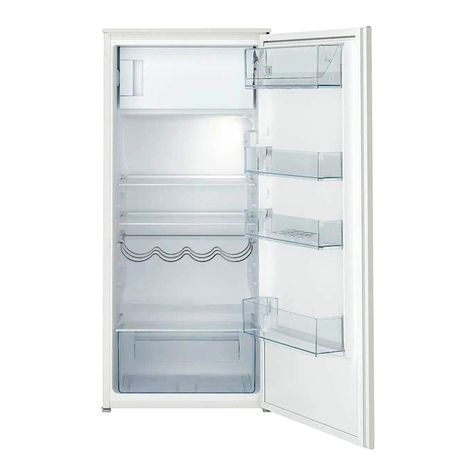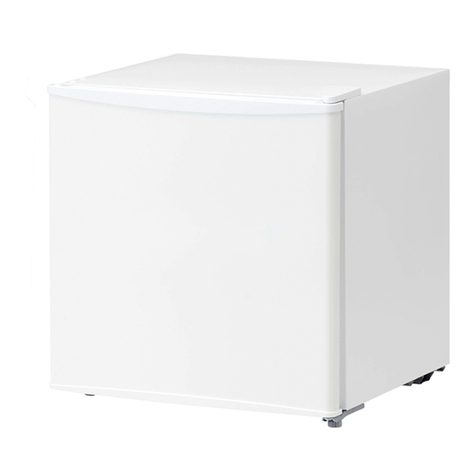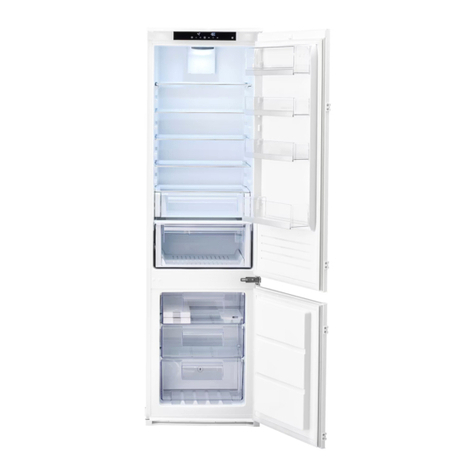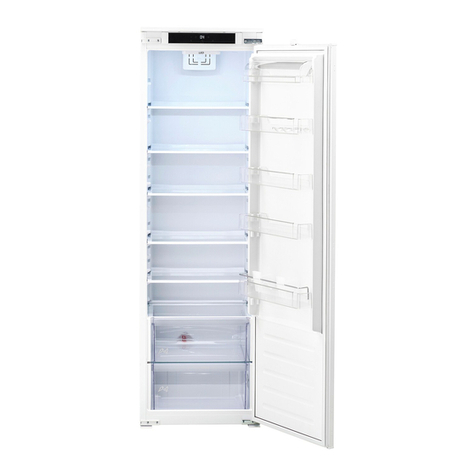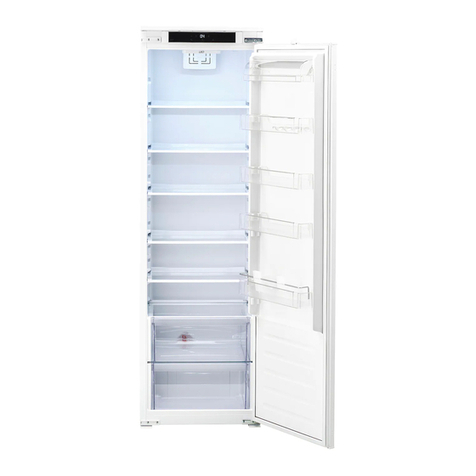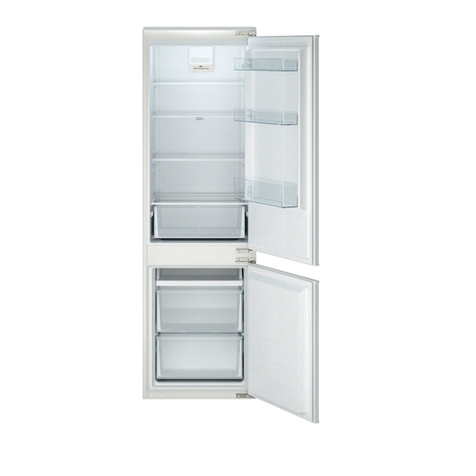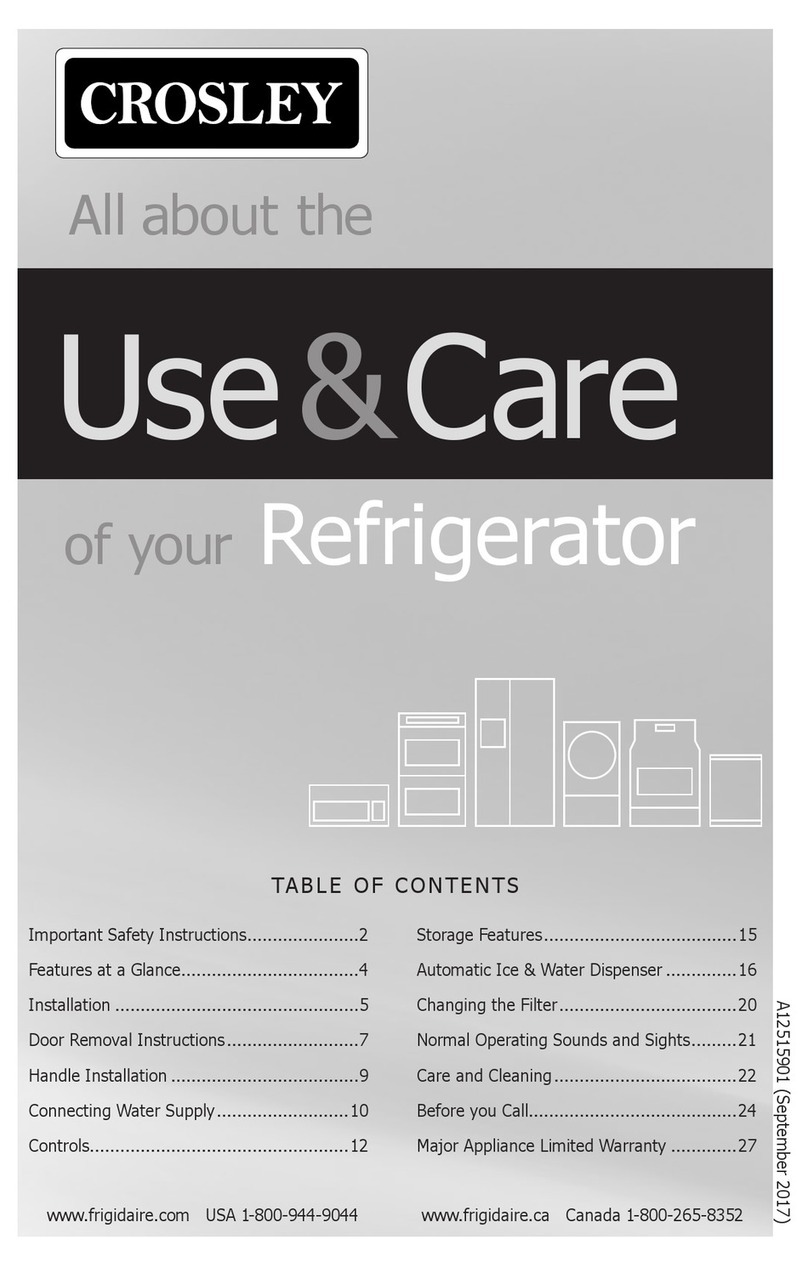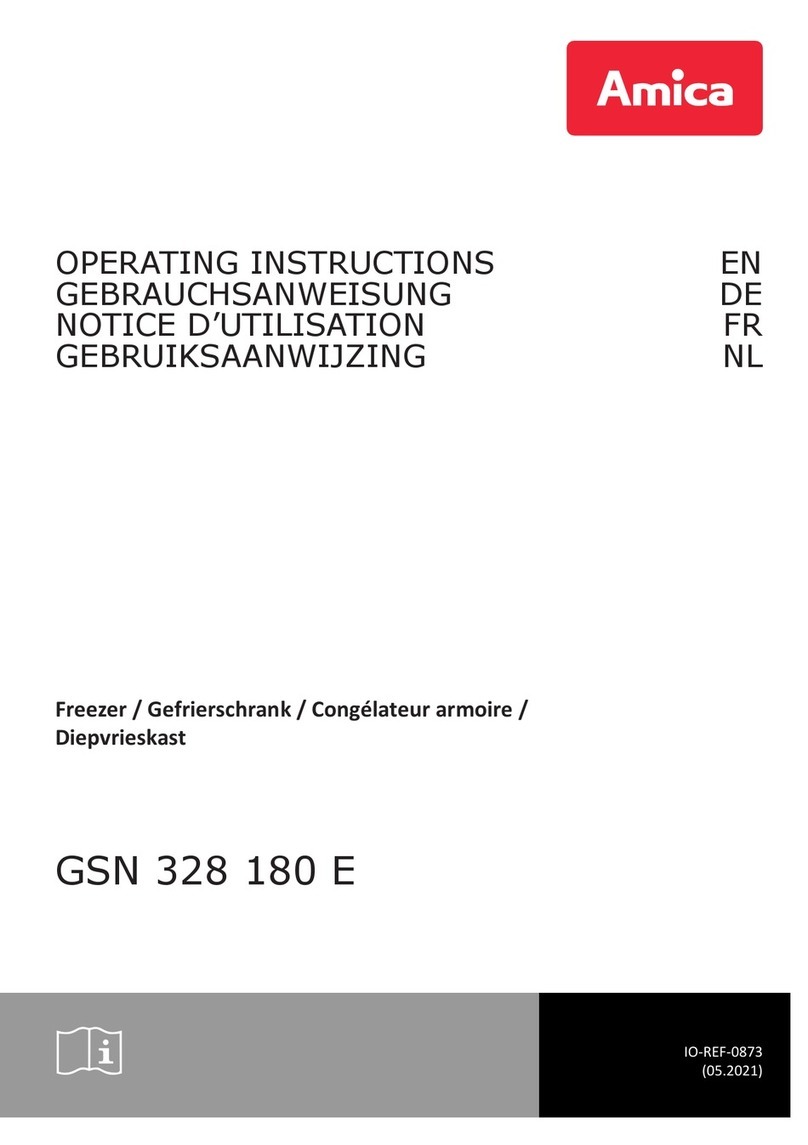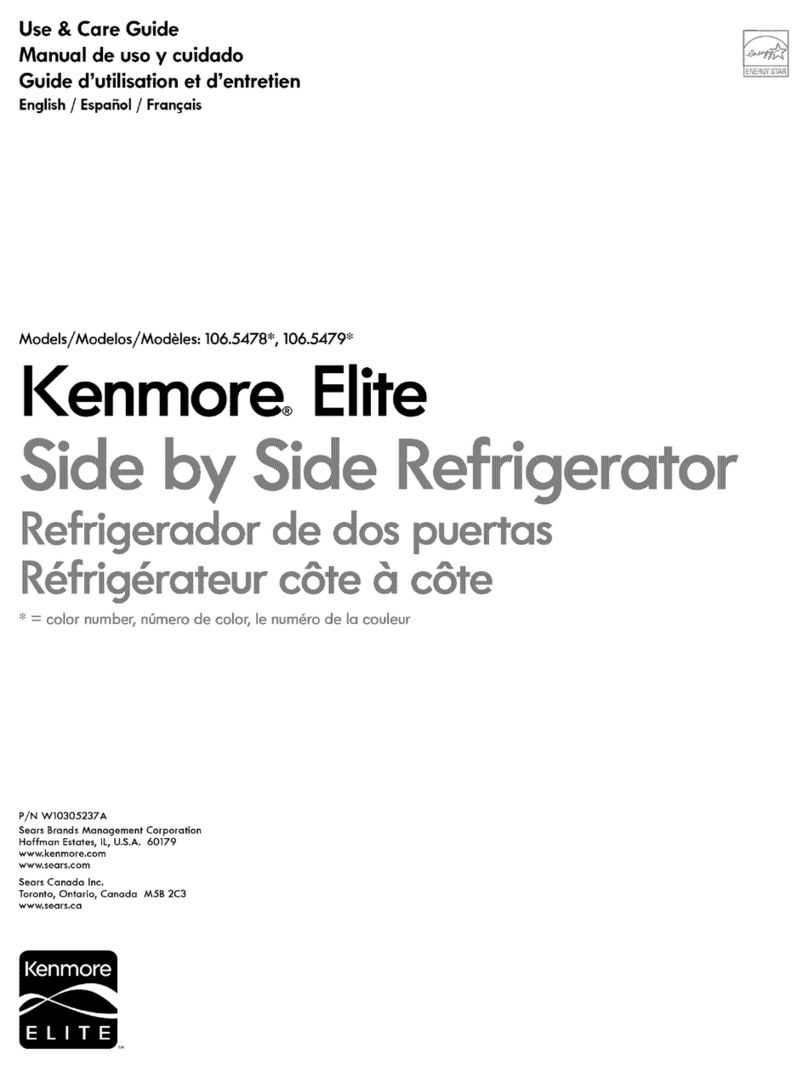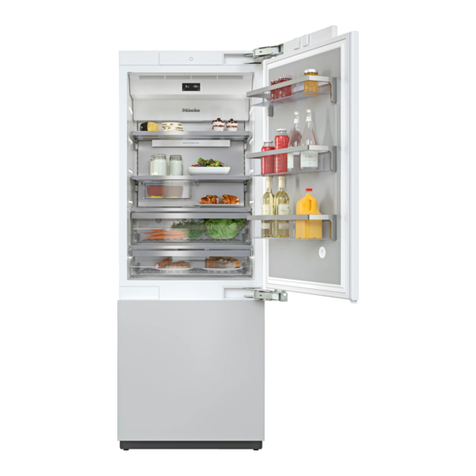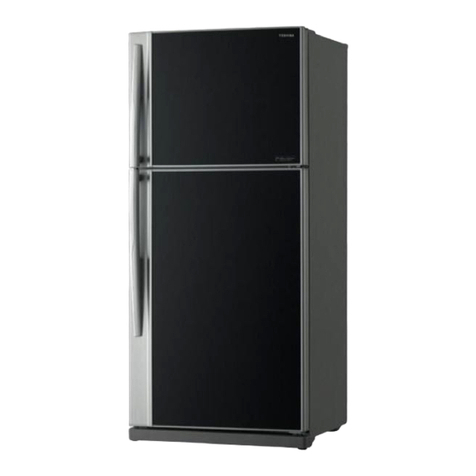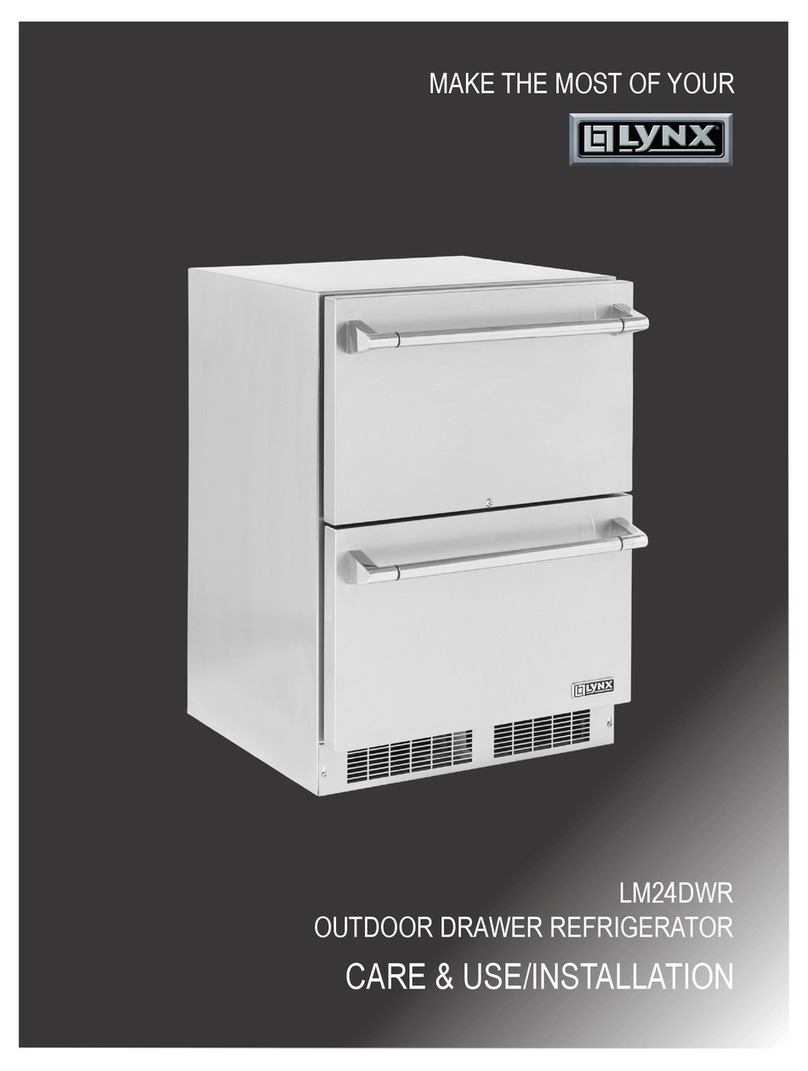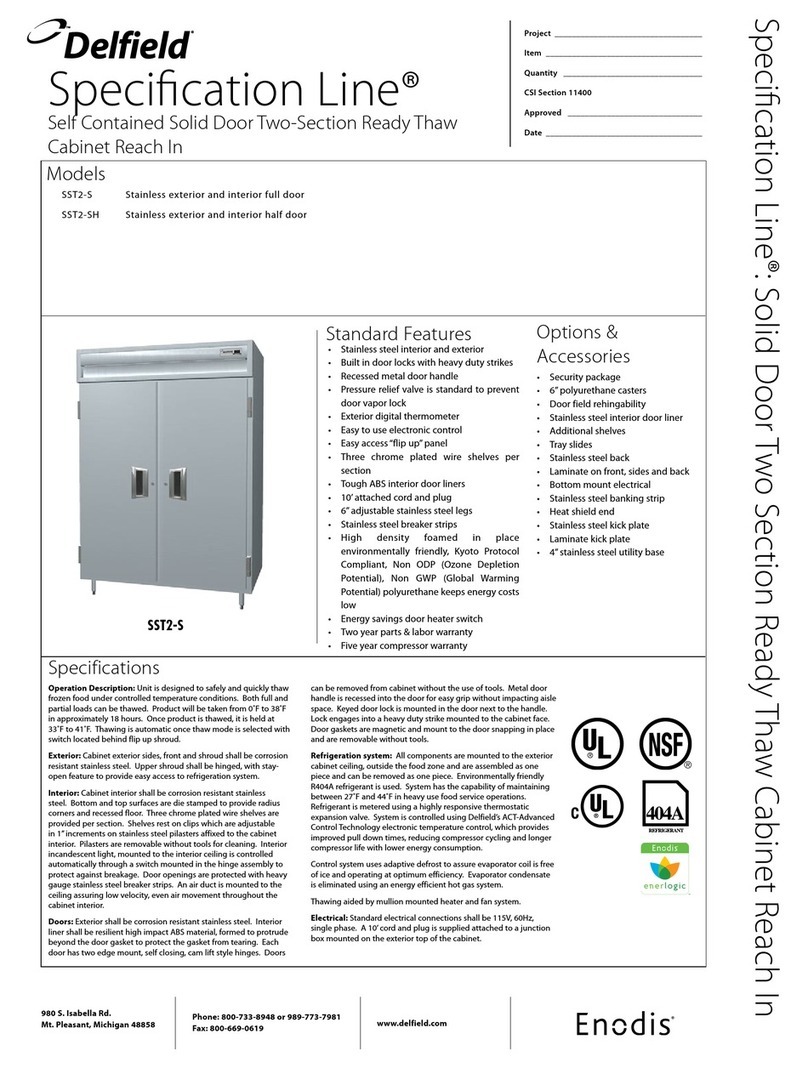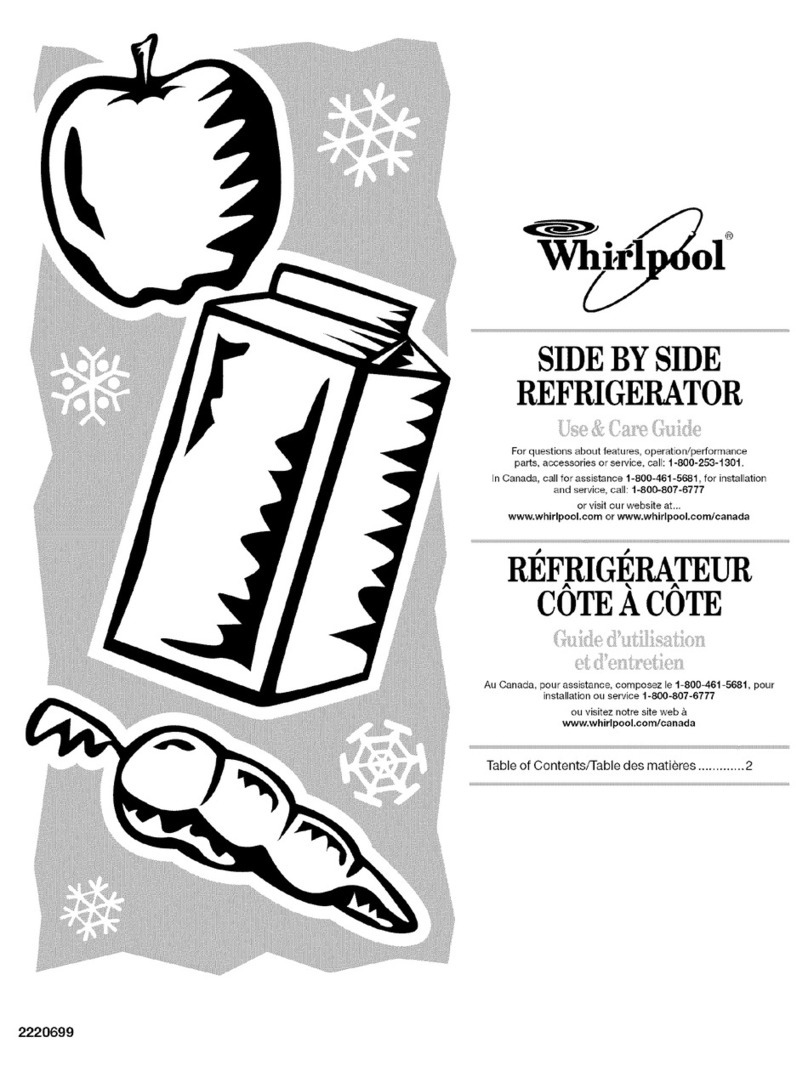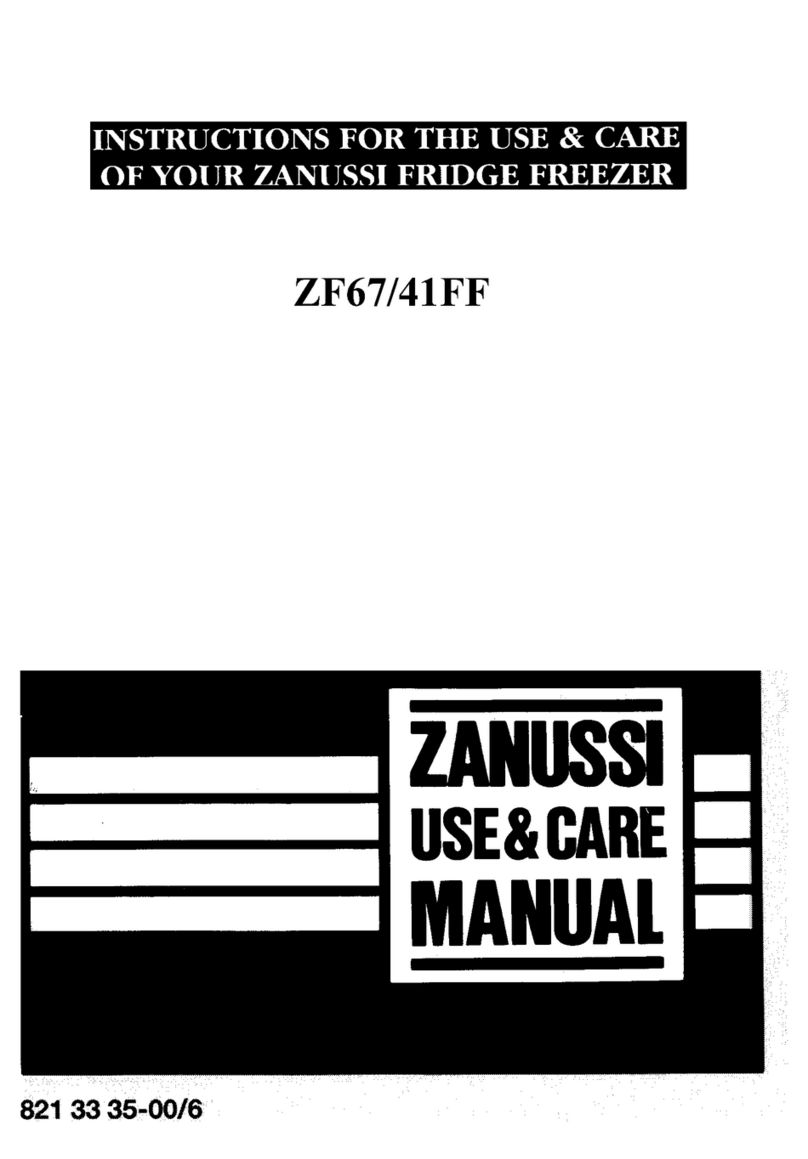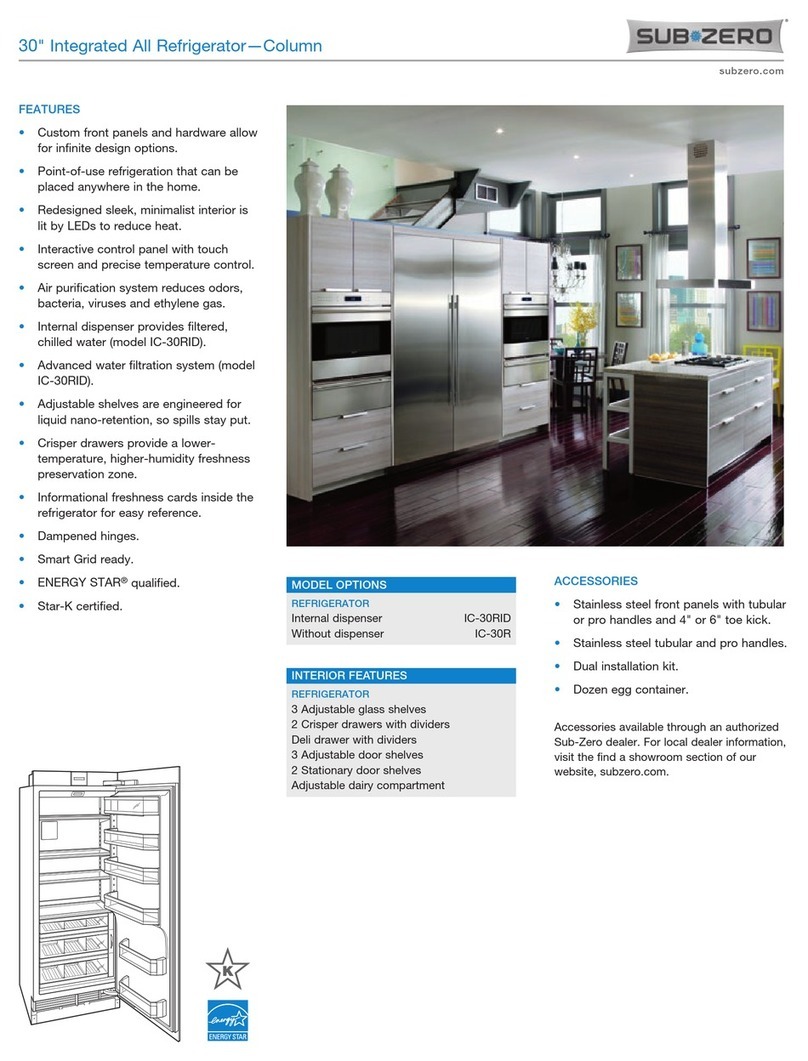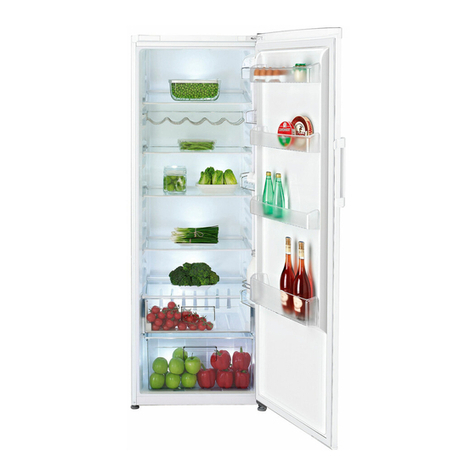IKEA MEDGÅNG User manual

MEDGÅNG GB

Please refer to
www.IKEA.com/au
and select your local store for local store phone numbers
and opening times.

ENGLISH 4

4ENGLISH
Contents
Safety information 4
Safety instructions 6
Installation 8
First use 9
Product description 10
Operation 11
Operation 12
Daily use 13
Hints and tips 14
Care and cleaning 16
Troubleshooting 17
Technical information 19
Environmental concerns 20
IKEA guarantee 20
Subject to change without notice.
Safety information
Before the installation and use of the appliance, carefully read
the supplied instructions. The manufacturer is not responsible
if an incorrect installation and use causes injuries and
damages. Always keep the instructions with the appliance for
future reference.
Children and vulnerable people safety
•
and above and persons with reduced physical, sensory or
mental capabilities or lack of experience and knowledge if
they have been given supervision or instruction concerning
the use of the appliance in a safe way and understand the
hazards involved.
• This appliance may be used by children between 3 and
disabilities, if they have been properly instructed.
• Children of less than 3 years of age should be kept away
unless continuously supervised.
• Do not let children play with the appliance.
• Children shall not carry out cleaning and user maintenance
of the appliance without supervision.
• Children aged from 3 to 8 years are allowed to load and
unload refrigerating appliances.

5ENGLISH
• Keep all packaging away from children and dispose of it
appropriately.
General Safety
• This appliance is intended to be used in household and
similar applications such as:
-
other working environments;
- By clients in hotels, motels, bed and breakfast and other
residential type environments;
• Do not use mechanical devices or other means to accelerate
the defrosting process, other than those recommended by
the manufacturer.
• Do not damage the refrigerant circuit.
• Do not use electrical appliances inside the food storage
compartments of the appliance, unless they are of the type
recommended by the manufacturer.
• Do not use water spray and steam to clean the appliance.
• Clean the appliance with a moist soft cloth. Only use neutral
detergents. Do not use abrasive products, abrasive cleaning
pads, solvents or metal objects.
• Do not store explosive substances such as aerosol cans with
• If the supply cord is damaged, it must be replaced by the
manufacturer, its Authorised Service Centre or similarly
• When positioning the appliance, ensure the supply cord is
not trapped or damaged.
• Do not locate multiple portable socket-outlets or portable
power supplies at the rear of the appliance.
•
increase of the temperature in the compartments of the
appliance.

6ENGLISH
• Clean regularly surfaces that can come in contact with food
and accessible drainage systems.
•
refrigerator, so that it is not in contact with or drip onto
other food.
• If the refrigerating appliance is left empty for long periods,
prevent mould developing within the appliance.
• Two-star frozen-food compartments are suitable for storing
pre-frozen food, storing or making ice-cream and making
ice cubes.
• One-, two- and three-star compartments are not suitable for
the freezing of fresh food.
• This refrigerating appliance is not intended to be used
as a built-in appliance. Keep ventilation openings, in the
appliance enclosure or in the built-in structure, clear of
obstruction.
• The appliance is equipped with a lamp for interior lighting.
Only service is allowed to replace the lighting device.
Contact your Authorised Service Centre.
• WARNING: To avoid a hazard due to instability of the
instructions.
Safety instructions
Installation
Warning!
install this appliance.
• Remove all the packaging and the transit
bolts.
• Do not install or use a damaged appliance.
• Follow the installation instruction supplied
with the appliance.
• Always take care when moving the
appliance as it is heavy. Always use safety
gloves and enclosed footwear.
• Make sure the air can circulate around the
appliance.
• Do not tilt the refrigerator for more
than 45° form upright during moving it.
•
door wait at least 4 hours before connecting
the appliance to the power supply. This is to

7ENGLISH
• Before carrying out any operations on the
appliance (e.g. reversing the door), remove
the plug from the power socket.
• Do not install the appliance close to
radiators or cookers, oven or hobs.
• The rear of the appliance must stand
against the wall.
• Do not install the appliance where there is
direct sunlight.
• Do not install this appliance in areas that
are too humid or too colds, such as the
construction appendices, garages or wine
cellars.
• When you move the appliance, lift it by the
Electrical connection
Warning!
Warning! When positioning the appliance,
ensure the supply cord is not trapped or
damaged.
Warning! Do not use multi-plug adapters
and extension cables.
• The appliance must be earthed.
• Make sure that the parameters on the rating
plate are compatible with the electrical
ratings of the mains power supply.
• Always use a correctly installed shockproof
socket.
• Make sure not to cause damage to the
electrical components (e.g. mains plug,
mains cable, compressor). Please refer to
www.IKEA.com/au
and contact our local store for local store
phone numbers and opening times or
have an electrician to change the electrical
components.
• The mains cable must stay below the level of
the mains plug.
Use
Warning! Risk of injury, burns, electrical
isobutane (R600a), a natural gas with a high
level of environmental compatibility. Be careful
not to cause damage to the refrigerant circuit
containing isobutane.
• The surface of the compressor may become
hot under normal operation. Do not touch it
with hands.
•
appliance.
•
cream makers) in the appliance unless they
are stated applicable by the manufacturer.
• If damage occurs to the refrigerant circuit,
sources of ignition in the room. Ventilate the
room.
• Do not let hot items to touch the plastic
parts of the appliance.
• Do not put soft drinks in the freezer
compartment. This will create pressure on
the drink container.
•
appliance.
•
near or on the appliance.
• Do not touch the condenser. They are hot.
• Do not remove or touch items from the
freezer compartment if your hands are wet
or damp.
• Do not freeze again food that has been
thawed.
• Follow the storage instructions on the
packaging of frozen food.
Internal lighting
Warning! Risk of electric shock.
• The lamp is only for interior lighting of the
appliance. Do not use it for house lighting.
Care and cleaning
Warning! Risk of injury or damage to the
appliance.

8ENGLISH
• Before maintenance, deactivate the
appliance and disconnect the mains plug
from the mains socket.
• This appliance contains hydrocarbons in the
the maintenance and the recharging of the
unit.
• Regularly examine the drain of the
appliance and if necessary, clean it. If the
drain is blocked, defrosted water collects in
the bottom of the appliance.
How to reach us if you need our service
• The IKEA after sales customer service center
will assist you on the phone with basic
trouble-shooting for your appliances at the
time of service call request. Please refer to
www.IKEA.com/au
and select your local store for local store
phone numbers and opening times.
Disposal
Warning!
• Disconnect the appliance from the mains
supply.
•
• Remove the door to prevent children and
pets to be closed inside of the appliance.
• The refrigerant circuit and the insulation
materials of this appliance are ozone-friendly.
•
gas. Contact your municipal authority for
information on how to discard the appliance
correctly.
• Do not cause damage to the part of the
cooling unit that is near the heat exchanger.
Installation
Warning! Refer to Safety chapters.
Positioning
• Follow the separate Assembly Instructions
to install this appliance.
• This appliance should be installed in a dry,
well ventilated indoor where the ambient
temperature corresponds to the climate
class indicated on the rating plate of the
appliance:
Climate class Ambient temperature
SN +10°C to +32°C
N +16°C to +32°C
ST +16°C to +38°C
T +16°C to +43°C
-"SN" indicates that this refrigerating
appliance is intended to be used at ambient
-"N" indicates that this refrigerating
appliance is intended to be used at ambient
-"ST" indicates that this refrigerating
appliance is intended to be used at ambient
-"T" indicates that this refrigerating
appliance is intended to be used at ambient
Some functional problems might occur
for some types of models when operating
outside of that range. The correct
operation can only be guaranteed within
have any doubts regarding installation,
please turn to the vendor, to our customer
service or to the nearest Authorised
Service Centre.
Location
• To ensure best performance, install the
appliance well away from sources of heat
such as radiators, boilers, direct sunlight
etc. Make sure that air can circulate freely
around the back of the cabinet.
• Install the supplied distance holder to allow
enough space between the refrigerator and
the wall (refer to the separate Assembly
Instructions).
If the installation of the supplied distance
holder is not possible, leave a space of at
the appliance and the ceiling.
• Leave enough space to access and open the
door easily (W x D ≥

9ENGLISH
W
D
Levelling feet
If the appliance tilts in some way, adjust the
height of the left/right foot of the appliance to
be in a horizontal level. Refer to the separate
Assembly Instructions for detailed installation.
1. Disconnect the mains plug of the appliance
from the power socket.
2. Turn the foot clockwise to raise the
appliance; turn the foot counter clockwise to
lower the appliance.
Reversing doors (optional)
Based on the location of the appliance, you
may need to reverse the doors to allow for easy
access to the appliance contents.
A suitable screwdriver and/or wrench is needed
for door re-installation.
Refer to the separate Assembly Instructions for
detailed installation.
Installing distance holder
Warning! Serious or fatal crushing injuries
can occur from appliance tip-over. ALWAYS
secure this appliance to the wall using tip-
over restraints.
the appliance to the wall for the following
advantages. Refer to the separate Assembly
Instructions for detailed installation.
• Allow enough space for air circulation
between the appliance and the walls.
• Secure the appliance to the wall for tip-over
prevention.
Electrical connection
Caution! Any electrical work required to
install this appliance should be carried
person.
Warning! This appliance must be earthed.
Failure to follow these instructions can
The manufacturer declines any liability should
these safety measures not be observed.
First use
Cleaning the interior
time,wash the interior and all internal
accessories with lukewarm water and same
neutral soap so as to remove the typical smell of
a brand new product, then dry thoroughly.
Important! Do not use detergents or abrasive

10ENGLISH
Product description
Product overview
1
2
3
4
5
6
7
8
9
1Door balconies
2Bottle balcony
3Door gaskets
4Freezer drawers
5Low temperature compartment
6Vegetable drawer
7Glass shelves
8LED lamp
9Control panel
Least cold zone
Intermediate temperature zone
Coldest zone

11ENGLISH
Operation
Control panel
12 3 4 5
1
2Refrigerator temperature button
3Refrigerator temperature indicators
4Freezer temperature button
5Freezer temperature indicators

12ENGLISH
Operation
Switching on
• Connect the mains plug to the power socket.
The display on the control panel turns on.
The temperature indicators show the set
default temperatures for the refrigerator
and the freezer compartments respectively.
• To change temperature, refer to the section
for temperature regulation.
When operating the
appliance
set the appliance at a colder temperature and
run it without loading any food until it auto
stops at the set temperature. Usually it takes
put food in the
appliance
.
Switching o
•
the 1
• To switch the appliance on, press and hold
the 1
To disconnect the appliance from the power
supply, disconnect the mains plug from the
power socket.
Temperature regulation for refrigerator
compartment
• Press the 2Refrigerator temperature
button to toggle the 3refrigerator
8˚C 4˚C 2˚C
• One ( ) on indicates °C is set.
• Two ( ) on indicate 4°C is set.
• Three ( ) on indicate 2°C is set.
Temperature regulation for freezer
compartment
• Press the 4Freezer temperature button
to toggle the 5freezer temperature
temperatures.
-16˚C -19˚C -24˚C
• One ( ) on indicates °C is set.
• Two ( ) on indicate -19°C is set.
• Three ( ) on indicate -24°C is set.
Adjust the temperature setting by keeping in
mind that the temperature inside the appliance
depends on:
• room temperature
• how often the door is opened
• the quantity of food stored
• the location of the appliance
Important! If the ambient temperature is
high or the appliance is fully loaded, and the
appliance is set to the lowest temperatures, it
may run continuously causing frost to form on
the rear wall. In this case a higher temperature
must be set to allow automatic defrosting and
therefore reduced energy consumption.
Door open alarm
If the door of the appliance is left open for two
minutes, the buzzer will sound continuously
close the door or press the 1 button.

13ENGLISH
Daily use
Freezing calendar
3-6
1-2
10 -12
3-4
10 -12
3-6
10 -12
3-6
10 -12
3-6
•
goods.
• The numbers indicate storage times in
months for the appropriate types of frozen
goods. Whether the upper or lower value of
the indicated storage time is valid depends
on the quality of the foods and treating
before freezing.
Freezing fresh food
• The freezer compartment is suitable for
freezing fresh food and storing frozen and
deep-frozen food for a long time.
• The maximum amount of food that can be
plate, a label located on the inside of the
appliance.
• The freezing process lasts 24 hours: during
this period do not add other food to be
frozen.
Storage of frozen food
•
of use, before putting the products in the
compartment let the appliance run at least
• Successful freezing depends on the correct
packaging. When you close and seal the
package you must not allow air or moisture
in or out. If you do, you could have food
odour and taste transfer throughout the
refrigerator, and also dry out frozen food.
•Note: Never put bottled food or drinks in
the freezer compartment.
• For best performance, leave enough
space in the freezer compartment for air
to circulate around the packages. Also let
enough room at the front so the door can
close tightly.
Warning! In the event of accidental
defrosting, for example due to a power
than the value shown in the technical
characteristics chart under “rising time”,
the defrosted food must be consumed
quickly or cooked immediately, cooled and
then re-frozen.
Thawing
Deep-frozen or frozen food, prior to being used,
can be thawed in the refrigerator compartment
or at room temperature, depending on the time
available for this operation.
Small pieces may even be cooked still frozen,
directly from the freezer: in this case, cooking
will take longer.
Storage of food in the refrigerator
compartment
• Cover or wrap the food, particularly if it has
• Position the food so that air can circulate
freely around it.
• For best performance, leave enough space
in the refrigerator compartment for air
to circulate around the packages. Also let
enough room at the front so the door can
close tightly.
Low temperature compartment
• The drawer is suitable for storing fresh
temperature is lower here than in the rest of
the refrigerator compartment.
• The low temperature compartment is
equipped with runners. You can pull it out of
the appliance.
Caution! Before placing or removing the
Low temperature compartment inside the
appliance, pull out the vegetable drawer
and glass cover.

14ENGLISH
Positioning the door balconies
Picture for reference only
• To permit storage of food packages of
various sizes, the door balconies can be
• Carefully remove a door balcony from the
support, then reposition it as desired.
Vegetable drawer
Picture for reference only
• The drawer is suitable for storing fruit and
vegetables.
• The drawer can be pulled out for cleaning.
Hints and tips
Normal operating sounds
The following sounds are normal during
operation:
• A faint gurgling and bubbling sound from
coils sound when refrigerant is pumped.
• A whirring and pulsating sound from the
compressor when refrigerant is pumped.
• A sudden cracking noise from inside
appliance caused by thermic dilatation
(a natural and not dangerous physical
phenomenon).
Hints for energy saving
• Do not open the door frequently or leave it
open longer than absolutely necessary.
• If the ambient temperature is high and very
low internal temperature is set and the
appliance is fully loaded, the compressor
may run continuously, causing frost or ice
on the evaporator. If this happens, set the
internal temperature toward warmer one to
allow automatic defrosting and so a saving
in electricity consumption.
Hints for fresh food refrigeration
• Do not store warm food or evaporating
liquids in the refrigerator.
• Cover or wrap the food, particularly if it has
• Position food so that air can circulate freely
around it.
Hints for refrigeration
Useful hints:
• Meat (all types): wrap in a suitable
packaging and place it on the glass shelf
above the vegetable drawer. Store meat for
at most 1-2 days.
• Cooked foods, cold dishes: cover and place
on any shelf.
• Fruit and vegetables: clean thoroughly and
place in a special drawer. Bananas, potatoes,
onions and garlic must not be kept in the
refrigerator if not packed.
• Butter and cheese: place in a special airtight
container or wrap in an aluminium foil or
a polythene bag to exclude as much air as
possible.
• Bottles: close with a cap and place on the
door bottle shelf, or (if available) on the
bottle rack.
Cautions for Use
•
the longer for once the door is opened, the
more it needs electric consumption, which
even leads malfunction.
• Re-plug in the power plug at the interval of
over ten minutes.

15ENGLISH
• Do not store bottled drink in the freezer,
so as to prevent from being broken and
damaging the refrigerator.
• Open the door as less as possible during
power-cut.
• When defrosting, never use any sharp or
metallic objects to remove the frost on the
surface of the evaporator as it will damage
the evaporator.
• Do not touch foods and containers in the
freezing compartment with your wet hands
so as to prevent from being frostbitten.
Hints for freezing
To help you make the most of the freezing
process, here are some important hints:
• The maximum quantity of food which can
plate.
•
further food to be frozen should be added
during this period.
• Freeze only top quality, fresh and
• Prepare food in small portions to enable it
to be rapidly and completely frozen and to
make it possible subsequently to thaw only
the quantity required.
• Wrap up the food in aluminium foil or
polythene and make sure that the packages
are airtight.
• Do not allow fresh, unfrozen food to touch
food which is already frozen, thus avoiding a
rise in temperature of the latter.
• Lean foods store better and longer than
fatty ones; salt reduces the storage life of
food.
• Water ices, if consumed immediately after
removal from the freezer compartment, can
possibly cause the skin to be freeze burnt.
• It is advisable to show the freezing in date
on each individual pack to enable you to
keep tab of the storage time.
Hints for storage of frozen food
To obtain the best performance from this
appliance, you should:
• Make sure that the commercially frozen
retailer.
•
transferred from the food store to the
freezer in the shortest possible time.
• Do not open the door frequently or leave it
open longer than absolutely necessary.
• Once defrosted, food deteriorates rapidly
and cannot be refrozen.
• Do not exceed the storage period indicated
by the food manufacturer.

16ENGLISH
Care and cleaning
Warning! Refer to Safety chapters.
General warnings
Caution! Unplug the appliance before
carrying out any maintenance operation.
This appliance contains hydrocarbons in its
cooling unit; maintenance and recharging
must therefore only be carried out by
authorized technicians.
The accessories and parts of the
appliance are not suitable for washing in a
dishwasher.
Cleaning the interior
interior and all internal accessories should be
washed with lukewarm water and some neutral
soap to remove the typical smell of a brand-new
product, then dried thoroughly.
Caution! Do not use detergents or
abrasive powders, as these will damage
Initial power on
Caution! Before inserting the power
plug in to the outlet and switching on
appliance standing upright for at least
amount of time for the oil to return to the
compressor. Otherwise the compressor
or electronic components may sustain
damage.
Periodic cleaning
Caution! Do not pull, move or damage any
pipes and/or cables inside the cabinet.
Caution! Do not damage the cooling
system.
Caution! When moving the cabinet, lift it
by the front edge to avoid scratching the
The equipment has to be cleaned regularly:
1. Clean the inside and accessories with
lukewarm water and some neutral soap.
2. Regularly check the door seals and wipe
clean to ensure they are clean and free from
debris.
3. Rinse and dry thoroughly.
4. If accessible, clean the condenser and the
compressor at the back of the appliance
with a brush. This operation will improve
the performance of the appliance and save
electricity consumption.
Periods of non-operation
When the appliance is not in use for long
periods, take the following precautions:
1. Disconnect the appliance from electricity
supply.
2. Remove all food.
3. Defrost (if necessary) and clean the
appliance and all accessories.
4. Clean the appliance and all accessories.
5. Leave the door/doors open to prevent
unpleasant smells.
Caution! If you want to keep the appliance
switched on, ask somebody to check it
once in a while to prevent the food inside
from spoiling in case of a power failure.
Defrosting fridge compartment
Frost is automatically eliminated from the
evaporator of the refrigerator compartment
every time the motor compressor stops,
during normal use. The defrost water drains
out through a trough into a special container
at the back of the appliance, over the motor
compressor, where it evaporates.
It is important to periodically clean the defrost
water drain hole at the back of the refrigerator
and dripping onto the food inside.
Defrosting freezer compartment
The freezer compartment has automatic
defrosting function.
Due to seasonal changes, a thick layer of frost
may form. To defrost manually, observe the
followings.
• Disconnect the appliance from the power
supply, and leave open the freezer door.
• Remove all foods, ice cube tray and shelf or
transfer to refrigerator compartment.

17ENGLISH
• Clean and wipe out the melted frost with a
cloth.
• After defrosting, connect the appliance to
the power supply.
Caution! To avoid damaging the freezer
compartment wall, do not use any sharp
objects to remove the frost or separate the
frozen food.
Troubleshooting
Warning! Refer to Safety chapters.
What to do if...
Problem Possible Cause Solution
The appliance does not operate.
The mains plug is not connected to the
mains socket correctly.
Connect the mains plug to the
mains socket correctly.
There is no voltage in the mains socket.
appliance to the mains socket.
The appliance is noisy. The appliance is not placed stably.
Level the feet of the appliance
to stabilize it. Refer to "Levelling
feet", or the separate Assembly
Instructions.
Acoustic alarm is on. The door is left open. Close the door. Refer to "Door
open alarm".
The lamp does not work. The lamp is defective. Refer to “Replacing the lamp”.
The temperature cannot be
adjusted.
A control mode (fast cooling, fast
freezing or vacation function if
applicable on your model ) is activated.
Deactivate the control mode. Refer
to “Operation” chapter.
The compressor operates
continually.
Temperature is set incorrectly. Refer to “Operation” chapter.
Many food products were inserted at the
same time.
Insert less food products at the
same time.
The room temperature is too high. Refer to climate class chart on the
rating plate.
Food products placed in the appliance
were too warm.
Allow food products to cool to
room temperature before storing.
The door is not closed correctly. Refer to “Closing the door”.
The temperature in the appliance
is too low/too high.
The temperature is not set correctly. Set a higher/lower temperature.
The door is not closed correctly. Refer to “Closing the door”.
The food products temperature is too
high.
Let the food products temperature
decrease to room temperature
before storage.
Many food products are inserted at the
same time.
Wait some hours and then check
the temperature again.
The thickness of the frost is greater than
Defrost the appliance.
The door has been opened often. Open the door only if necessary.
There is no cold air circulation in the
appliance.
Make sure that there is cold air
circulation in the appliance.

18ENGLISH
Problem Possible Cause Solution
There is too much condensed
water on the rear wall of the
refrigerator.
Door was opened too frequently. Open the door only when
necessary.
Door was not closed completely. Make sure the door is closed
completely.
Stored food was not wrapped. Wrap food in suitable packaging
before storing it in the appliance.
refrigerator.
The drain hole at the back of the
appliance is clogged.
Clean the drain hole with a piece
of wire.
Food products prevent water from
Make sure that food products do
not touch the rear plate.
The door is not closed well.
Refer to "Closing the door", or
refer to the troubleshooting item
below ("The door does not close
completely").
The drip pan cracks.
The IKEA after sales customer
service center will assist you on the
phone at the time of service call
request. Please refer to
www.IKEA.com/au
and select your local store for local
store phone numbers and opening
times.
The defrost water drain is clogged. Clean the drain hole with a piece
of wire.
The doors does not close
completely.
The door gaskets are dirty. Clean the door gaskets.
The appliance is not level.
Make sure the appliances
is installed in level. Refer to
"Levelling feet", or the separate
Assembly Instructions
Malfunction alarm
If the appliance malfunctions, the LED indicators
and the buzzer will sound. To switch the buzzer
1 button.
• and
Temperature sensor failure
of the refrigerator chamber
• and
Temperature sensor failure
of the freezer chamber
• and
Defrosting sensor failure of
the freezer chamber
• and
Communication failure
• and
Failure of ambient
temperature sensor
If your appliance still is not working
properly after making the above checks,
the IKEA after sales customer service
center will assist you on the phone at the
time of service call request. Please refer to
www.IKEA.com/au
and select your local store for local store
phone numbers and opening times.
Closing the door
1. Clean the door gaskets.
2. If necessary, adjust the door. Refer to the
separate Assembly Instructions.
3. If necessary, replace the defective door
gaskets. Contact the After Sales Service.

19ENGLISH
Replacing the lamp
The appliance is equipped with a lamp for
interior lighting.
Only service is allowed to replace the lighting
device. Contact your Authorised Service Centre.
For quick solution, always refer to the full list
of Authorised Service Centre located at the
end of this manual and call your relative phone
number.
Technical information
Product category
Product type Refrigerator - Freezer
Installation type Freestanding
Product dimensions
Height 1874 mm
Width 595 mm
Depth 630 mm
Net volume
Fridge 219 L
Freezer 83 L
Defrost system
Fridge Auto
Freezer Auto
Energy consumption 308 kWh/y
Energy class MEPS 3.5 stars
Voltage 220 - 240 V
Frequency 50 Hz
XXX.XXX.XX
Serial No.: xxxxxxxxxxxxxxx
Article Number
(8-digit code)
Picture for reference only
Serial Number (start
with SN, 22-digit
code)
The article number and the serial number
are situated in the rating plate on the
internal left side of the appliance.

20ENGLISH
Environmental concerns
Recycle materials with the symbol . Put the
packaging in relevant containers to recycle it.
Help protect the environment and human health
by recycling waste of electrical and electronic
appliances. Do not dispose of this product
with the household waste. Return the product
to your local recycling facility or contact your
IKEA guarantee
How long is the IKEA guarantee valid?
the original date of purchase of your appliance
at IKEA. The original sales receipt is required
as proof of purchase. If service work is carried
out under guarantee, this will not extend the
guarantee period for the appliance.
Who will execute the service?
IKEA service provider will provide the service
through its own service operations or
authorized service partner network.
What does this guarantee cover?
The guarantee covers faults of the appliance,
which have been caused by faulty construction
or material faults from the date of purchase
from IKEA. This guarantee applies to domestic
the headline “What is not covered under this
guarantee?” Within the guarantee period, the
costs to remedy the fault e.g. repairs, parts,
labour and travel will be covered, provided that
the appliance is accessible for repair without
special expenditure. On these conditions the
respective local regulations are applicable.
Replaced parts become the property of IKEA.
The guarantee exists only if the appliance
complies and is installed in accordance with:
•
• The Assembly Instructions and user manual
Safety Information.
IKEA’s guarantee is subject to Australian
Consumer Law - see Schedule 2 to Competition
and Consumer Act, 2010. This guarantee is in
addition to (and does not exclude, restrict or
modify in any way) any non-excludable statutory
warranties in Australia.
What will IKEA do to correct the problem?
IKEA appointed Service Provider will examine
the product and decide, at its sole discretion, if
it is covered under this guarantee. If considered
covered, IKEA Service Provider or its authorized
service partner through its own service
operations, will then, at its sole discretion, either
repair the defective product or replace it with
the same or a comparable product.
What is not covered under this guarantee?
• Normal wear and tear.
• Deliberate or negligent damage, damage
caused by failure to observe operating
instructions, incorrect installation or by
connection to the wrong voltage, damage
caused by chemical or electro-chemical
reaction, rust, corrosion or water damage
including but not limited to damage caused
by excessive lime in the water supply,
damage caused by abnormal environmental
conditions.
• Consumable parts including batteries and
lamps.
• Non-functional and decorative parts which
including any scratches and possible color
• Accidental damage caused by foreign
objects or substances and cleaning or
soap drawers.
Other manuals for MEDGÅNG
2
This manual suits for next models
1
Table of contents
Other IKEA Refrigerator manuals
